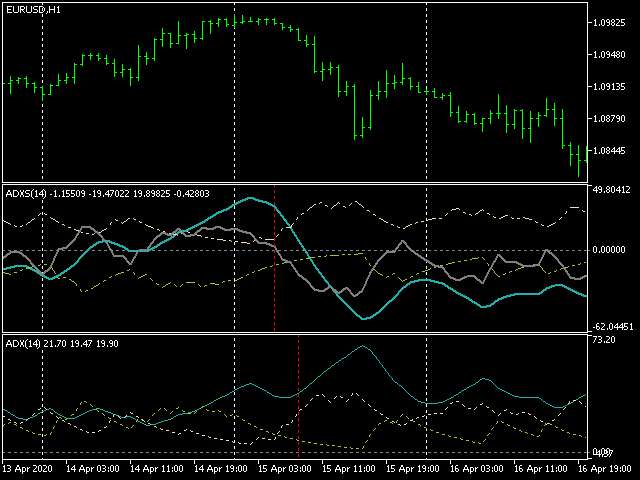Reworking the standard ADX to get more understandable and effective trading signals.
The indicator calculates ADX using standard formulas, but excludes the operation of taking the module from the ADX values, which for some reason is artificially added to ADX. In other words, the indicator retains the original sign of the ADX values, which makes them more accurate, easier to use and earlier than the standard ADX. Strictly speaking, any transformation like taking a module destroys part of the information, and therefore it makes sense to exclude it. In addition, the indicator introduces additional buffers for ease of use.
The indicator displays 4 lines:
- directly ADX with a sign – a thick light blue line;
- (-DI) negative movement index – dashed light brown line (always positive);
- -( DI) inverted index of positive movement – dashed dashed light green line (always negative);
- ( DI)-(-DI) the difference between the two indexes is a thick gray line.
While traditional ADX is always positive, ADXSignal can be both positive and negative. ADXSignal signals are similar to ADX signals, but more understandable:
- When ADXSignal grows (it doesn’t matter – above or below 0), there is an upward trend. When ADXSignal declines (it doesn’t matter – above or below 0), there is a downward trend.
- The moment when a position should be opened in the direction of the trend is determined by the fact that the index difference crosses zero in the corresponding direction. Usually, according to the ADX rules, you buy when DI goes above -DI, and sell when DI goes below -DI, but ADXSignal provides a single convenient buffer for this – 4th: when it is > 0, buy when < 0, sale.
- It is also easy to notice that the (-DI) and -( DI) lines form a channel that gives additional confirmation signals – for example, when the difference goes beyond the channel, the signal is amplified compared to the intersection of 0; this can be used for “topping up”.
[spoiler title=”Read More…”]
The screenshots show how ADXSignal behaves in comparison with the usual ADX. It is easy to notice that ADXSignal signals are formed earlier than ADX. At the points where vertical lines are installed, ADXSignal has already “decided” on a new trend and gives a signal, and ADX still shows a decrease, so it’s too early to enter according to it.
Parameters: ADX period (default is 14), and notification settings (AlertType – internal terminal alert, email, push notification, AlertCondition – formula, AlertName – signal name). In the formula, variables are available for the values of 4 buffers (ADXS, PDI, NDI and the sum of PDI NDI) on 3 bars:
- Buffer 0: ADXS – ADX0, ADX1, ADX2 [signed]
- Buffer 1: -( DI) – PDI0, PDI1, PDI2 or DN0, DN1, DN2 [always negative]
- Buffer 2: (-DI) – NDI0, NDI1, NDI2 or UP0, UP1, UP2 [always positive]
- Buffer 3: ( DI)-(-DI) – SUM0, SUM1, SUM2 [signed]
Example formula for two signals (buy 1, 2, sell -1, -2):
ADX2>DN2





